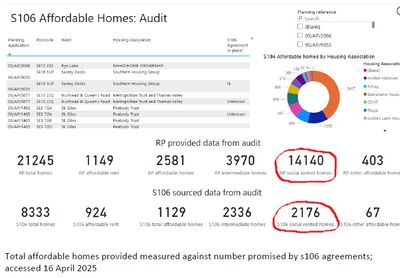
Southwark Council appear to have abandoned the annual audits of affordable housing monitoring that they promised to conduct in response to a critical Ombudsman’s report in 2016.
Only two audits have been conducted since that date, in 2016 and 2022. This contrary to what is stated on Southwark’s Housing delivery webpage, which says that they have conducted annually since 2021. The development of a proper online tool that could replace the need for monitoring was also abandoned.
Since the first decision, a second Ombudsman’s report has found no fault with Southwark's monitoring process.
Southwark’s Housing delivery webpages
Southwark Council’s Housing delivery webpage has the 'latest registered provider survey results' which have replaced the annual audit. The survey results are displayed using tables, a pie chart and an interactive map.
Clicking on the pie chart of registered providers brings up a table of their affordable housing developments. A further click on one of the listed developments brings up a circle on the interactive map. Hover over the circle and a label giving the postcode and number of homes in the development appears; right click on the label and then left click on the ‘Show data point as a table’ option leads to a table giving the development’s details.
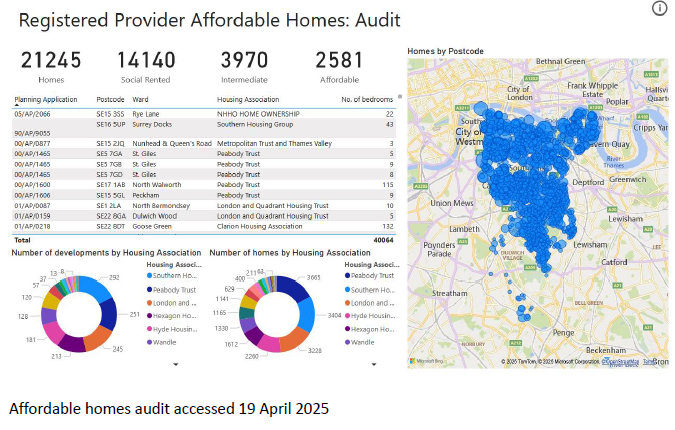
Taking a closer look
Superficially it all looks good, but on closer examination it becomes clear that the ‘survey results’ do not tell us what we need to know, which is whether or not we are getting the affordable housing we should be getting - the whole purpose of an audit.
Starting on the landing page, it's immediately clear that the figures for the three categories of affordable housing (social rent, intermediate, affordable) do not add up to the number of total homes.
We accessed the page on several separate days, including 22 March and 2 April. On neither occasion did the total number of affordable homes equal the number for the three types of affordable housing - on 22 March they total 20,364 (not 23,546) and on 2 April they total 20,691 (not 21,245) a difference of 3,182 and 554 respectively. [^1]
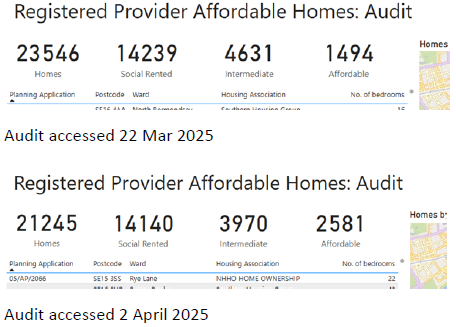
On top of this, the total number of homes also appears to have fallen between those dates, from 23,546 to 21,245 homes - this is surprising, given that the audit is being continually updated by information about newly completed schemes.
The numbers of social rent and intermediate units also fell, while the affordable housing units rose, giving a net gain of 327 affordable homes of all kinds.
In short, it appears that over this time registered providers have collectively told Southwark that it has fewer homes, with fewer social rent and intermediate units, but more other affordable, while leaving over five hundred and fifty units uncategorised (on 2 April).
Southern Housing's returns
Moving onto individual providers and taking Southern Housing as an example, we can see that the same problem is repeated; on 22 March the total number of homes provided is given as 3,580, but has fallen to 3,404 by the 2 April.
On 22 March adding the three affordable housing categories together gives a sum of 2,995, against a total of 3580 homes, leaving 585 homes uncategorised. On the 2 April the respective figures are 2,869 against a total of 3404, leaving 535 uncategorised.
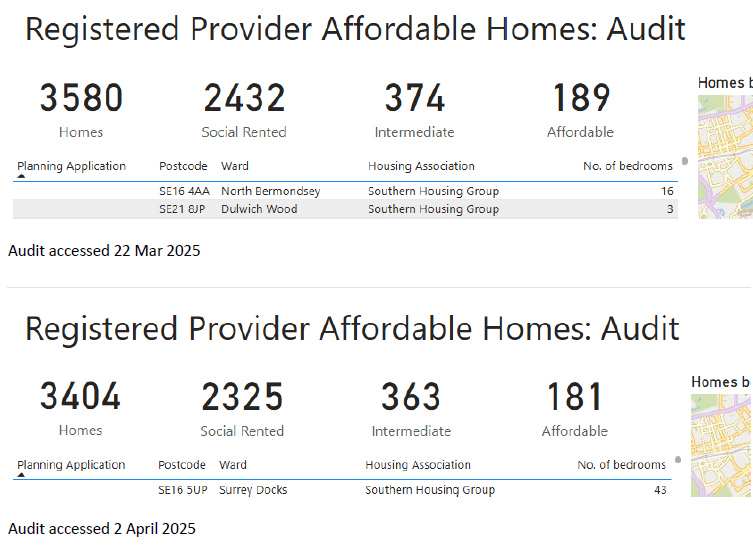
Clicking at random one of Southern’s schemes, 03/AP/1044, shows a similar problem; the figures only add up to 54 when the total is 80, leaving 26 homes uncategorised.
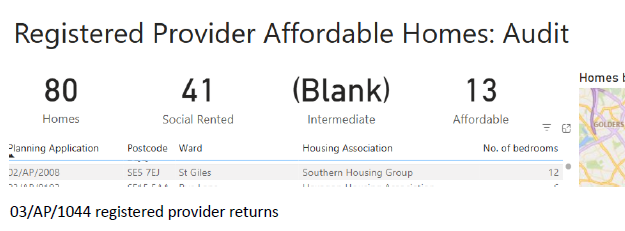
Checking the data table shows that the missing 26 units are shared-ownership and that the thirteen ‘Affordable’ homes are let at London Affordable Rents; this does not appear in the figures displayed. London Affordable Rent is specifically excluded from the list of acceptable intermediate housing in the Southwark Plan 2022 and did not exist as an affordable housing category in 2006, the date of the s106 agreement which secured the affordable housing. [^2]
The s106 agreement for the development tells us that the scheme was originally to have 31 affordable homes, out of 82 total units, so, notwithstanding the LAR units, it appears there has been a welcome increase of 49 affordable housing units, but that has not been captured. [^3]

Looking further - another provider
Checking out another big registered provider, London & Quadrant (L&Q), also throws up the same problem - an apparant fall in total homes from 4,001 on 25 March to 3,228 on 2 April.
The figures of 25 March for the three types of affordable housing also do not add up to the total, only amounting to 3,454, leaving 547 homes uncategorised. On 2 April the combined figure is 3,075, leaving 153 homes uncategorised.
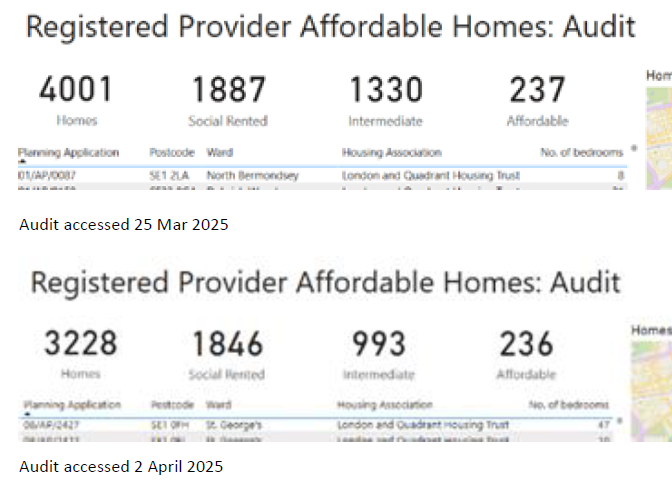
The figures don't add up
The second page of the audit has the most critical information [^4] – this shows whether or not we are getting the affordable housing that has been promised by developers. Again, as with the data for registered providers and for individual schemes, the figures do not add up.
What should be delivered is determined by all the legal s106 agreements that developers sign with the Council. The s106 data provided by the registered provider shows that 21,245 have been provided, whereas the number of homes that the s106 agreements say should be provided is 8,333 – a difference of 12,912 homes.
The figures for the five categories of affordable housing show similar large differences . The difference for social housing is particularly striking; the registered provider provided data shows that they have provided 14,140 social rented homes, while the s106 agreements only require that they provide 2,176 – a massive difference of 11,964 homes which, if it is to be believed, means that private developers and their registered providers partners have delivered over six times more affordable housing than they were required to do.
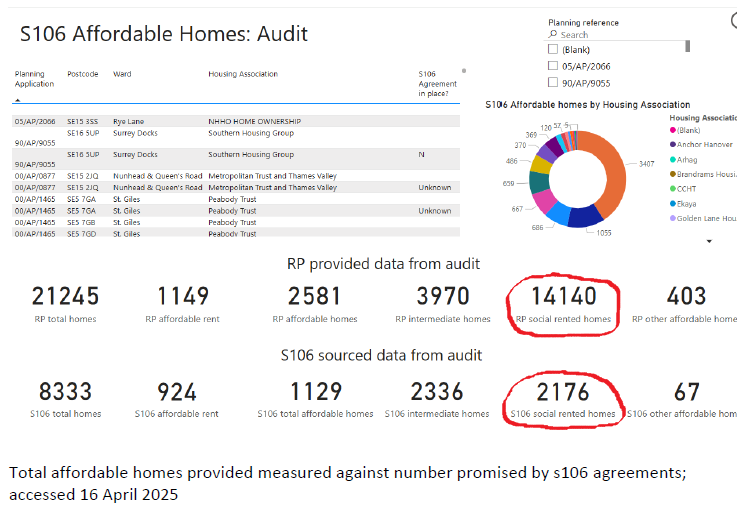
What we think
It is very difficult to make sense of Southwark's audit of the amount of affordable housing registered providers are delivering, as explained on their Housing delivery pages. Southwark say that the purpose of the audit is 'To find out how many affordable homes are in Southwark (excluding our own)'. This is important information and the necessary baseline for any audit.
But Southwark also wants to ensure that registered providers deliver promised affordable housing, saying 'Affordable housing is monitored to make sure it is built and managed as we agreed with developers and housing associations'. This cannot be done if Southwark allows the figures for delivery simply to accumulate, on a rolling basis, without any attempt to reconcile them against what has been agreed.
Southwark refers to 'an audit period' and says ‘Results are published as soon as a response is received......and the data has been validated....This means the results will update throughout the audit period’, but Southwark does not say what the audit period is; nor does it provide any explanation of, for example, the huge difference between the social rent s106 figure and the much bigger registered provider figure. Our Southern Housing example appears to show an uncaptured gain of 49 affordable homes, but it can't be assumed that over twelve thousand social rent units can be explained by similar missing data.
It may be that the registered providers have given data for their entire affordable and social rent stock (^5), but if that is the case Southwark cannot say for certain that it includes new s106 homes; these would need to be filterred out and there is no indication that this has been done.
Also, the audit relies on getting accurate information from registered providers and too often this does not happen. The Council also does not always have an up-to-date s106 agreement for each development, and without this Southwark is simply trusting in the reliability of the registered providers.
Whatever the explanation, Southwark should not just rest on a favourable Ombudsman’s decision to deflect any criticism of the audit, when it is so clearly not achieving its purpose. The second Ombudman’s decision was only concerned with the process of the audit, not the outcomes. Southwark had also previously given the Ombudsman an undertaking that there would be an annual audit, which it only partial fulfilled and now looks to be abandoning, leaving us not much further forward with a proper auditing process than we were in 2016.
Footnotes:
[^1] Screen shots of audit pages are from 22, 25 March and 2, 16, 19 April 2025. Figures vary overtime, as our blogpost explains.
[^2] Southwark Plan 2022, P1 Social rented and intermediate housing, Fact box, Social housing and intermediate housing, pg 112
[^3] The 49 extra homes are calculated by subtracting the thirty-one promised in the s106 from the 80 figure displayed on the audit page. The s106, dated 9 Jan 2006, can be found via Southwark’s planning register, using ref 03/AP/1044 in the search box.
[^4] Click on < 1 of 3 > at bottom of webpage, to change pages.
[^5] A note on page 3 refers to 'historic planning permissions', without defining them. These 'historic' schemes are listed in the audit, but generaly do not have S106 data . The full note says 'S106 sourced data from audit - This is data sourced by the council from S106 agreements showing the affordable housing which is required to be provided at each development. S106 data is not available fro every development in the audit as council records do not generally cover historic planning permissions. As such, this data is a subset ot the overall affordable housing picture in the borough'.